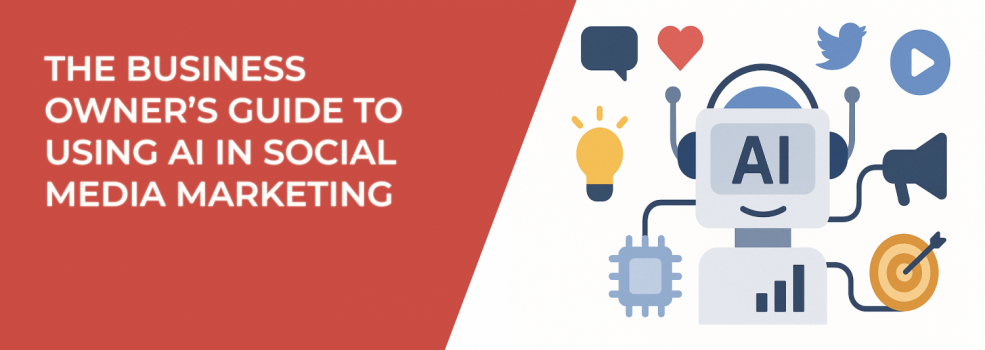Running a business in 2025 means wearing a lot of hats. Social media marketing? That’s one of the heaviest. AI can help lighten the load — if you know how to use it without creating more problems than you solve.
This guide breaks down the smart, safe, and practical ways to put AI to work in your social strategy — without losing the human touch that makes your brand connect.
Why Use AI for Social Media Marketing?
AI helps small teams punch above their weight. It speeds up content production, automates repetitive tasks, and finds patterns in your data that you'd otherwise miss. Used right, it gives you time back — and insight forward.
It’s especially helpful for business owners who don’t have time to post daily or analyze performance manually. But AI isn’t perfect. It can produce off-brand messaging, miss context, or optimize for the wrong goals. That’s why it’s not a replacement — it’s a multiplier.
Used with intention, AI allows you to create faster, test smarter, and manage your campaigns with more focus. But it still needs oversight, strategy, and your human instinct to work.
1. Use AI to Speed Up Content Creation — But Keep It Human
AI tools can generate caption ideas, outline blog posts, or rewrite copy across formats. It’s a huge time-saver. But without editing, that content often sounds robotic or vague.
Here’s how to make it work:
-
Use AI to draft ideas — not final copy. Treat it like a writing assistant, not your head of content.
-
Give it real input: tell it your audience, product benefits, tone, and channel format.
-
Once you get a draft, rewrite key sections using your own brand voice or stories.
These steps keep your messaging clear and personal — instead of sounding like generic filler. AI should make content creation easier, not less engaging.
Example: A handmade soap brand can ask AI to suggest 10 product launch post ideas, then choose the most relevant ones, refine them with sensory language, and pair them with customer reviews or behind-the-scenes details. That way, it’s fast — but still personal.
If you’re new to AI tools, here’s a curated list that saves time: The Best AI Text and Image Generators.
2. Train AI on Your Brand — Not Just the Internet
The reason most AI-generated content falls flat? It doesn’t know you. If you feed it only generic prompts, you’ll get generic output. To get better results, you need to train the tools — not in a technical way, but by giving them brand-specific input.
Start here:
-
Create a swipe file of successful social posts, emails, and product descriptions.
-
Build reusable prompts that mention your ideal customer, product categories, and writing style.
-
Document do’s and don’ts — preferred words, tone direction, formatting rules.
Doing this once can save you hours in the long run. It helps the AI learn your style so that future content requires less editing and feels more consistent with your brand.
Example: A service-based business like a legal consultant can upload past client Q&As and blog posts to an AI writing assistant, then use prompts like: “Write a LinkedIn post that answers a common question small business owners ask about contract disputes. Use a calm, helpful tone and no jargon.”
If you’re exploring more advanced ways to blend AI into your creative process, see How to Automate Campaign Performance with AI Tools.
3. Use AI to Improve Ad Performance — But Monitor Closely
AI ad tools are great for quick testing, basic automation, and performance analysis. They help you launch more variations, faster. But they don’t understand your positioning, seasonal relevance, or long-term business goals. That’s why they need human oversight.
To use AI effectively:
-
Let it generate variations of your ad copy, images, and CTA buttons.
-
Set up automation rules — like pausing ads after a set CPA threshold.
-
Review weekly reports and assess real outcomes like lead quality or purchase behavior.
These tactics help you run smarter campaigns without micromanaging every detail. But you still need to analyze whether the results match your goals — because AI won’t always know what “success” means for your business.
Example: A local real estate agent promoting virtual tours can use AI to test whether short videos perform better than image carousels, generate three headlines per ad, and rotate creatives automatically based on engagement. But you’ll still need to evaluate whether the leads are qualified — and make the call on what to scale.
Want to improve results without raising spend? You’ll appreciate this: How to Improve Campaign Performance with AI Tools.
4. Let AI Help With Targeting — But Don’t Rely on Guesswork
AI can analyze behavioral data and recommend audiences, but it still needs strategic direction. The suggestions it offers might look good on the surface, but they won’t always align with your buyer journey or conversion path.
What to focus on:
-
Use AI to find patterns in who’s engaging — by age, device, behavior, or content type.
-
Layer targeting rules based on actual actions — not just broad interests.
-
Continuously test audiences against performance goals like ROAS, not just engagement.
These steps help you avoid wasted spend. The more specific your audience data, the better AI can refine and improve it over time — but only if you're reviewing results manually.
Example: A digital course creator promoting a time management course might find AI recommending audiences interested in “productivity” or “self-help.” But manual analysis shows that their best customers are solopreneurs aged 30–45 who clicked on their email lead magnet. That’s the data you use to adjust your ad targeting.
Want more structure for building better targeting with automation? Start with this guide: Testing AI-Powered Facebook Ad Tools for Targeting in 2025: Are They Worth It?
5. Avoid These Common Pitfalls (And Fix Them Early)
AI can be helpful, but it’s not always right — or safe to trust without checks. Here are the biggest mistakes business owners make when using AI in social media, and how to avoid each one.
-
Mistake 1: Fully automating your brand voice.
Raw AI output often sounds flat. You risk losing brand personality and trust.
→ Fix: Review every post before publishing. Add your style, stories, and point of view. -
Mistake 2: Relying too much on AI-suggested ad settings.
The system may prioritize engagement over sales.
→ Fix: Manually track key business metrics, like cost per purchase or lead quality. -
Mistake 3: Publishing AI content without a human filter.
Unedited content often repeats phrases or misses nuance.
→ Fix: Read it out loud. Would you say this to a customer? If not, rewrite it. -
Mistake 4: Blindly following AI-generated audiences.
Not all suggested interests or lookalikes are meaningful.
→ Fix: Review conversion rates by segment. Keep what works, cut what doesn’t. -
Mistake 5: Skipping legal and platform compliance checks.
AI may create claims or visuals that trigger ad rejections.
→ Fix: Always review the policies of the platforms you're using.
Avoiding these missteps early keeps your campaigns clean, your account safe, and your brand on track. AI should help you grow — not make more work fixing mistakes.
Final Thoughts
AI isn’t a magic wand. It’s a smart assistant — one that helps you move faster, test smarter, and manage your brand with less guesswork. But like any tool, its value depends on how you use it.
The best approach is a hybrid one: let AI do the repetitive tasks. Let you drive the strategy. Let results lead the way.
When you build a system where AI handles the heavy lifting and you stay behind the wheel, you get more done, waste less time, and stay in control of your brand.

